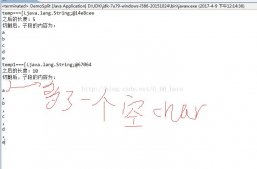互斥锁和信号量都是操作系统中为并发编程设计基本概念,互斥锁和信号量的概念上的不同在于,对于同一个资源,互斥锁只有0和1 的概念,而信号量不止于此。也就是说,信号量可以使资源同时被多个线程访问,而互斥锁同时只能被一个线程访问
互斥锁在java中的实现就是 ReetranLock , 在访问一个同步资源时,它的对象需要通过方法 tryLock() 获得这个锁,如果失败,返回 false,成功返回true。根据返回的信息来判断是否要访问这个被同步的资源。看下面的例子
|
1
2
3
4
5
6
7
8
9
10
11
12
13
14
15
16
17
18
19
20
21
22
23
24
25
26
27
28
29
30
31
|
public class ReentranLockExample { private static int count = 0; private static ReentrantLock reentrantLock = new ReentrantLock(); static class MyThread extends Thread{ @Override public void run() { super.run(); try { while (true){ boolean result = reentrantLock.tryLock(); if (result){ System.out.println(Thread.currentThread().getName() + "get the lock success and run the syn code " + count ++); reentrantLock.unlock(); }else{ System.out.println(Thread.currentThread().getName() + "get the lock failed and run the syn code " + count); } System.out.println(Thread.currentThread().getName() + "run the asyntronized code " + count); Thread.sleep(500); } } catch (InterruptedException e) { e.printStackTrace(); } } } public static void main(String[] args){ MyThread thread1 = new MyThread(); MyThread thread2 = new MyThread(); thread1.start(); thread2.start(); }} |
信号量相当于一个计数器,如果线程想要访问某个资源,则先要获得这个资源的信号量,并且信号量内部的计数器减1 ,信号量内部的计数器大于0则意味着有可以使用的资源,当线程使用完某个资源时,必须释放这个资源的信号量。信号量的一个作用就是可以实现指定个线程去同事访问某个资源。只需要在初始化 。
信号量在 Java中的实现是 Semaphore ,其在初始化时传入一个整型数, 用来指定同步资源最大的并发访问量
|
1
2
3
4
5
6
7
8
9
10
11
12
13
14
15
16
17
18
19
20
21
22
23
24
25
26
27
28
29
30
|
public class SemaphoreExample { private static Semaphore semaphore = new Semaphore(2); private String lock = "lock"; private static int count = 0; static class MyThread extends Thread { @Override public void run() { super.run(); try { while (true) { semaphore.acquire(); Thread.sleep(500); System.out.println(Thread.currentThread().getName() + "get the lock success and run the syn code " + count++); semaphore.release(); Thread.sleep(500); } } catch (InterruptedException e) { e.printStackTrace(); } } } public static void main(String[] args){ MyThread thread1 = new MyThread(); MyThread thread2 = new MyThread(); MyThread thread3 = new MyThread(); thread1.start(); thread2.start(); thread3.start(); }} |
CountDownLatch 实现一个等待机制,在诸如 等待与会者到达后,开始会议的使用中。ConutDownLatch 在初始化中一个计数器,用来指定需要等待的个数。在并发编程中,所解决的需求就是,等待所有的线程到达某个点后。才开始进行下一步,有点类似于开会,只有当所有的与会人员都到齐后,会议才能开始
|
1
2
3
4
5
6
7
8
9
10
11
12
13
14
15
16
17
18
19
20
21
22
23
24
25
26
27
28
29
30
31
32
|
public class CountDownLatchExample { private static CountDownLatch mCountDownLatch = new CountDownLatch(3); static class MyThread extends Thread { int awaitTime; public MyThread(int i) { this.awaitTime = i; } @Override public void run() { super.run(); try { while (true) { Thread.sleep(awaitTime); System.out.println(Thread.currentThread().getName() + "arrived " ); mCountDownLatch.countDown(); mCountDownLatch.await(); //可以指定等待时间 System.out.println(Thread.currentThread().getName() + "start meeting " ); } } catch (InterruptedException e) { e.printStackTrace(); } } } public static void main(String[] args){ MyThread thread1 = new MyThread(500); MyThread thread2 = new MyThread(1000); MyThread thread3 = new MyThread(2000); thread1.start(); thread2.start(); thread3.start(); }} |
总结
以上就是本文有关Java编程中的互斥锁,信号量和多线程等待机制实例详解的全部内容,希望对大家有所帮助。
原文链接:http://blog.csdn.net/feifeiwendao/article/details/52212719















